
Efficient powering (for sail and motor vessels) is primarily a function of the speed length ratio (SLR) at which the hull operates. To determine your SLR simply take the square root of your waterline length, and divide this into the boat speed. A 36 foot waterline has a square root of six, and at seven knots would be operating at a SLR of 1.18.
For almost all vessels, sail, power, pleasure, and commercial, you will get the most distance for a given quantity of fuel at a SLR of .9. So, for our 36 foot waterline example that’s a speed of 5.4 knots.
With AIS we can check the basic dimensions of the ships we see, note how fast they are going, and get a feel for their efficiency by looking at the bow and stern waves. This is particularly interesting in Norway where ship design is a highly developed art (and has been for at least 12 centuries).
Take the ferry in the top photo.
She is operating at 15 knots, or an SLR of .9 (no surprise here). Considering the volume of this load carrying design, the bow wave is minuscule.
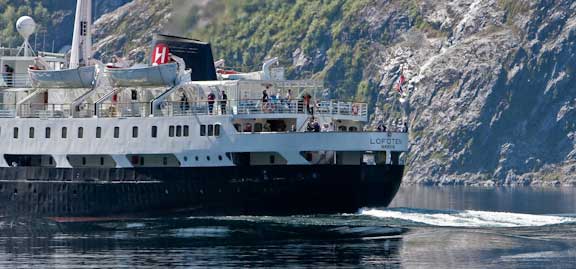
Check out the stern wave, or lack thereof. The Lofoten makes barely a ripple pushing her bulk through the water.

For comparison here is a mega-yacht of the same size (285 feet) going the same speed (15 knots) as Lofoten. This vessel will probably displace half of the ferry’s weight. Yet the bow and stern waves are larger.
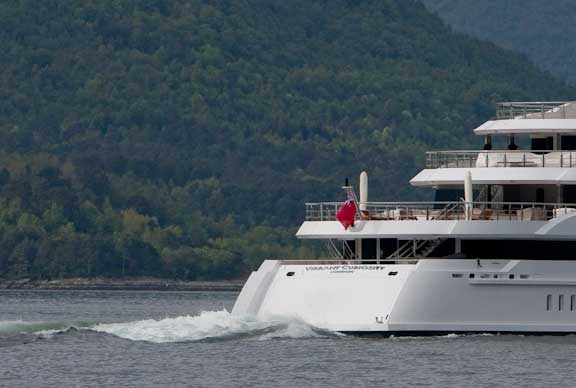
Here is a close up of the stern wave. At least the wave is pushed past the end of the hull.
Efficiency is not everything, and the cost benefits of efficient powering on a yacht are usually far down on the list of benefits. What are most important are noise, vibration, and range, all of which are directly related to the power being used.
At slow SLRs, like .9, the shape of the hull is not that critical for efficiency. If you forget steering and comfort, you can push almost any shape at a slow speed. But as the desire to go faster comes into play, the shape of the hull becomes more critical.
How the volume is distributed along the waterline can achieve major increases in efficiency and speed. The trick is balancing this against the required sea-keeping abilities.
Stern shape is a huge factor in all of this.
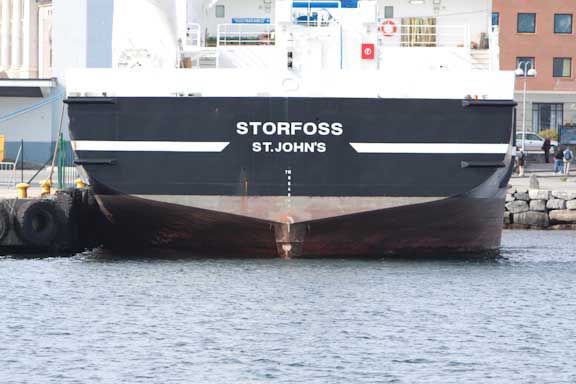
There are several factors at play. One is the amount of stern immersed. This relates to many other factors, but to keep it simple, the slower the SLR, the less stern immersion you want. Higher speeds find a certain amount desirable. This is measured as a percentage of the maximum cross sectional area of the boat.
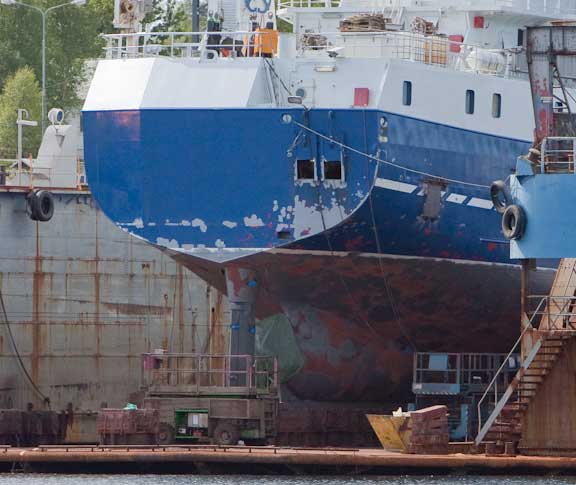
For slower speeds the stern should not be immersed more than five to ten percent (a gross simplification) of the maximum cross section. The trawler in the photo above is unloaded, but the bottom paint line will give you an idea of how little stern is immersed when she is loaded.
This same rule applies under sail, and at slower speeds an immersed stern is a poor performer. But as you start to operate at faster SLRs, immersion brings benefits.
There are other factors to be considered with yachts, like propeller cover in bouncy conditions, transom slap at anchor, and what happens to the transom volume with heel. Nobody said this was easy.
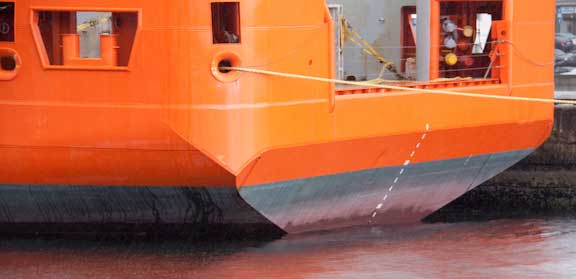
There is no perfect stern shape, and there are as many approaches to this as there are designers. This is the back end of an oil platform support vessel. Much more v-shaped than what we have been observing. This might have a softer motion than a wider, flatter shape.
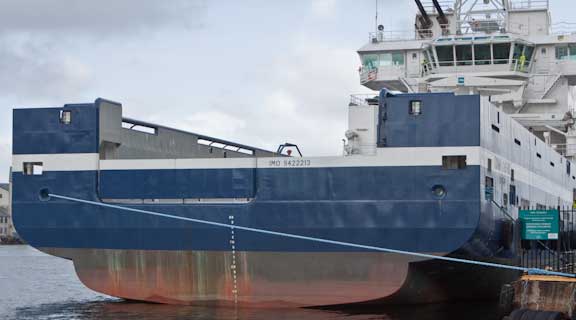
To confuse the discussion how about this shape. Here the trade off is tilted toward a wide, rectangular deck for maximum load carrying.
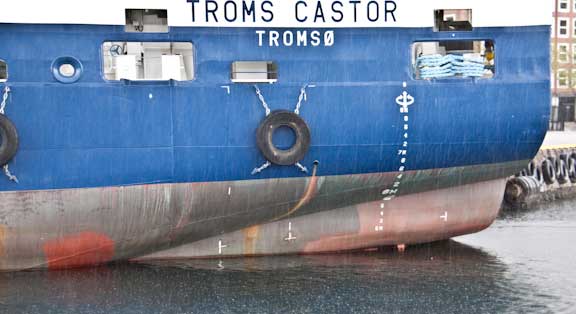
But the crew probably feel those “wings” when they slam down as a head sea passes under the hull. If you are like us, you are probably scratching your head about the Troms Castor approach. You can bet a lot of tank testing and CFD simulation, and debate went into the decision to build the first one.
Sailboats need to develop stability with the hull shape which further complicates the situation. Broad sterns are fast reaching and running because the stability they bring helps more than the increase in drag hurts. But too much beam makes the boat hard to steer, and slow going to weather.
Displacement for a given length also affects how these factors play out. As the boat gets lighter for its length, there are more options on how you can deal with the ends of the boat. Distribution of volume can be oriented more towards steering control and comfort, with less of an efficiency penalty.
We have used immersed sterns on our sailing designs for two decades. Yes, they are a little slower in light airs, but they are faster under power, which is what a cruising boat does in light winds. And they are faster and safer in heavier winds.
On the FPB 83 we are so efficient that we can afford to operate at a higher SLR, typically 1.22(eleven knots). A lower SLR like .9 (eight knots) would double our mileage, but eleven is comfortable at sea and still quiet and vibration free. We only get away with this in a long distance context by being totally committed to the most efficient combination of hull shape and drive line.
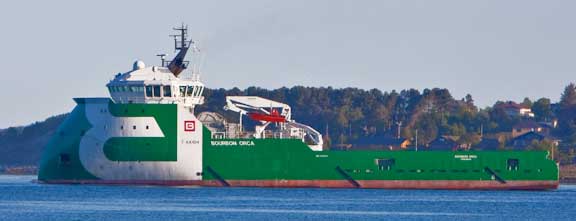
If you have read our FPB design pages you know that the bow and stern have to relate in terms of underwater volume and how they react in head seas. Here is a new breed of offshore oil platform support vessel. Note the low volume bow, with very little reserve buoyancy.
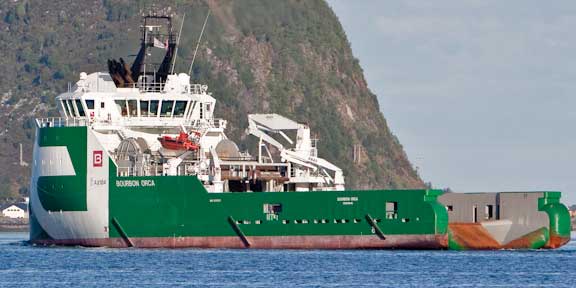
This is an attempt to give the wave less to push on as it encounters the bow. Having talked with the captain of one of these vessels it appears that they are indeed more comfortable than the conventional bluff bowed designs.

Keep in mind that these rules apply to all floating objects, large and small, including this 20 footer with its lovely canoe stern. Since we are in Norway, the home of double enders, we will talk about these in another blog.

May 17th, 2009 at 6:01 am
Hi Steve,
first thaks for all you publish on the windhorse and setsail sites; it’s always interesting and valuable. The Windhorse reports are brilliant. I especially enjoyed the logs from west coast US to UK.
Question, when you compute the SLR for a multihull, do you add the wl lengths of the 2 hulls then take that square root to divide into your speed?
Case in point, my 59′ wl length and my 20knt fast cruise vs mt 10knt passage speed.
keep up the great work,
Bill
May 19th, 2009 at 11:27 am
As the hulls get narrower and lighter the relationship between wave drag and wetted surface drag changes. Where wave drag dominates at speed for heavier and fatter configurations, wetted surface is the key for your multihull situation. The same basic rules apply, but the speed length ratio you can efficiently operate at goes up. How far up depends on wave interference. displacement, and length to beam ratio.
In our olden catamaran sailing days we consistently sailed at SLRs of four and above. Beowulf, our last sailing monohull would average an easy SLR of 1.45 in the trades (300 miles a day on a 75 foot waterline) under sail and 1.25/1.3 under power. Wind Horse normally cruises at 1.2/1.22. However, if range or cost is the primary issue, then slowing down will benefit, just not as much as with a heavier vessel.
June 21st, 2013 at 11:06 am
Steve,
Interesting discussion of SLR. I advise a group of students that design and race canoes made out of concrete. Perhaps you have heard of that competition common in Civil Engineering programs at Universities. We have started to design our canoes using a basic but powerful software design tool called Prolines 7 that has provided us with a lot of info that perhaps a bunch of CE’s don’t know how to interpret. Our canoe are typically about 20 feet long, 30 inches wide at widest point, and weigh between 180 and 200 lbs. I believe best speed as paddles is about 3.2 knots or 1.6 to 1.7 meters per second. This puts our speed to length ratio at about .73 (feel free to correct me if I’m wrong). We have done some work to develop the appropriate shape of our canoe using the prismatic coefficient Cp. With all that said, I am intrigued by your discussion above of stern displacement. Based on our characteristics above, do you think this stern displacement has any impact on our design…should we be trying to decrease our stern displacement by perhaps increasing the rocker in the stern to minimize that profile? Typically our canoes come to a point both bow and stern with bow having significant rocker (almost bringing the bottom of the canoe up to the top of the canoe making a point at the front…but not quite) with the stern being essentially vertical. Any thoughts if I have confused you too much? Be happy to forward pictures.
June 23rd, 2013 at 3:02 pm
Hi Matt:
Interesting project. There are so many variables I am not sure where to point you. What I would do is study the paddleboard racers, and traditional canoe/pirogue builders.